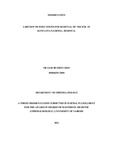| dc.contributor.author | Said, Hussein | |
| dc.date.accessioned | 2015-08-27T12:32:34Z | |
| dc.date.available | 2015-08-27T12:32:34Z | |
| dc.date.issued | 2014 | |
| dc.identifier.citation | Masters in Medicine (Ophthalmology) | en_US |
| dc.identifier.uri | http://hdl.handle.net/11295/90198 | |
| dc.description.abstract | Background: Life threatening conditions such as ocular malignancies are main
reasons for removal of the eyes, other reasons include: ocular trauma and
endophthalmitis. This removal of the eyes can have significant impact on a person’s
body image and his or her role in the society. The devastating effect of removal may
result in monocular and/or binocular blindness. There is no current data in Kenyatta
National Hospital since the last study was done two and a half decades ago (1986) and
a lot has changed since then in terms of better diagnostic services and management.
Objective: To determine the indications for removal of the eye at Kenyatta National
Hospital.
Methodology: The study was a retrospective case series carried out at Kenyatta
National Hospital to identify patients who underwent eye removal procedures
between September 2002 and September 2012. Basic demographic data, diagnosis,
the eye affected, visual acuity at diagnosis and eye removal procedure performed
were extracted from the patient’s file and recorded in questionnaires. Descriptive
analysis was used to assess indicators for eye removal while the agreement between
diagnostics was compared using kappa statistics. All the analyses were done using
STATA version 11.
Results: A total of 261 patients’ files were reviewed during the study period and 281
eyes were analyzed. The majority (129) were under 10 years of age (49.42%) with a
male to female ratio of 1.5:1. The most common type of surgery done was enucleation
in 141 (50.18%), followed by exenteration in 89 (31.67%) and evisceration in 52
(18.51%). The most common indication for eye removal was retinoblastoma
(42.35%), followed by squamous cell carcinoma (25.27%) and the least was phthisis
bulbi (0.38%). The agreement between clinical and histopathological diagnosis was
high at 93.10% (95%CI: 87.52-94.64; kappa value=0.83, P<0.001).
Conclusion: Tumors were still the commonest indications of eye removal at Kenyatta
National while painful blind eye and phthisis bulbi are now rarely considered for
removal of eyes. All specimens should be taken for histology irrespective of what the
clinical diagnosis was. | en_US |
| dc.language.iso | en | en_US |
| dc.publisher | University of Nairobi | en_US |
| dc.title | A review of indications for removal of the eye at Kenyatta national hospital | en_US |
| dc.type | Thesis | en_US |
| dc.description.department | a
Department of Psychiatry, University of Nairobi, ; bDepartment of Mental Health, School of Medicine,
Moi University, Eldoret, Kenya | |
| dc.type.material | en_US | en_US |

